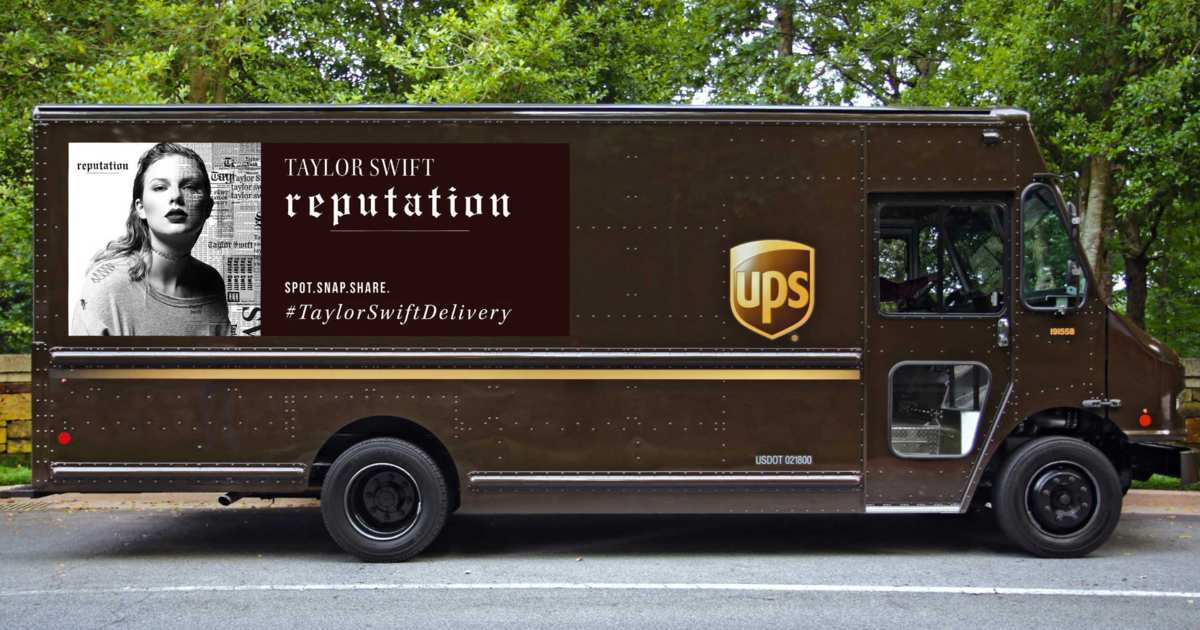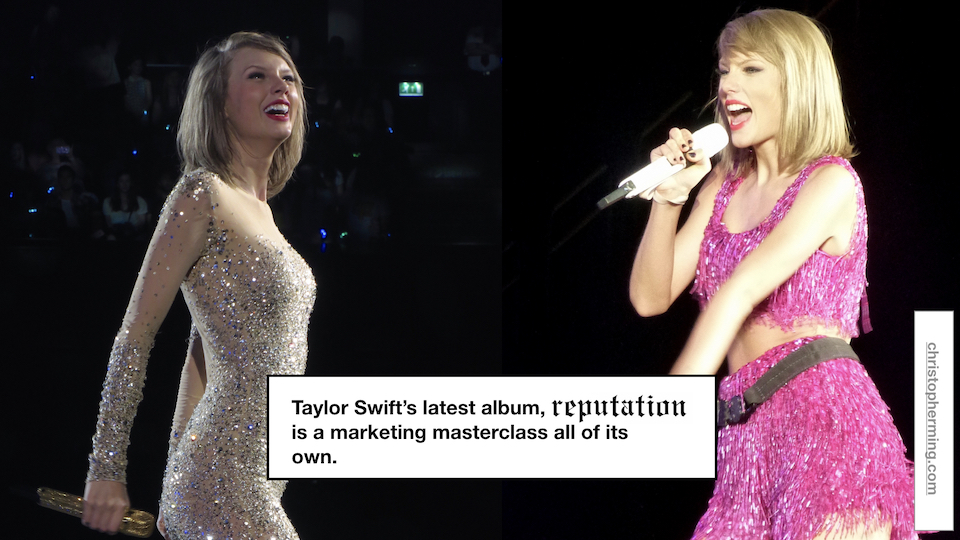I can’t say Taylor Swift is my favorite songwriter.
When it comes to conveying complex emotions, she doesn’t hold the beer of contemporaries like Sara Bareilles or Lorde.
Take Red, where she uses colors to describe a former relationship. The color blue represents sadness. Red? You guessed it: love.
And:
“Fighting with him was like trying to solve a crossword and realizing there’s no right answer…”
…where she jams four additional syllables into a convoluted line.
Or Gorgeous, the third single off Reputation. As one Swiftie lamented, “she rhymes ‘face’ with ‘face.'”
So no, Taylor Swift is not my favorite songwriter.
But…
The vitriol her music, brand, and popularity attracts is more egregious than any poorly constructed lyric.
One critic writes about the first release off the new album:
“Look What You Made Me Do, a critically reviled song, is the fifth number 1 single off Taylor Swift’s career. It’s also a failure… where Reputation will likely sell a few million copies to her broad base of hard-core fans while nonetheless being dismissed by critics.”
“Three years later, that aversion (hip-hop’s influence of pop music) has brought Swift to the brink of obsolescence.”[note] https://www.theringer.com/music/2017/11/9/16625006/taylor-swift-reputation-chart-singles[/note]
This “brink of obsolescence” quip is laughable, considering how many facets of the music game Ms. Swift not only does well but does better than anyone else:
- Five #1 singles as a lead artist and five (out of six) #1 albums.
- A catalog of music videos that feel relevant in an age when music videos lost their relevance. Her marketing team released the Blank Space music video alongside an app that allowed you to explore the set and discover Easter Eggs. Ms. Swift unveiled a series of Frank-Miller-inspired movie-style character posters across her social media in anticipation of the Bad Blood music video. And of course, Look What You Made Me Do, the first single off of Reputation, sparked numerous fan theories about the embedded references (e.g. the tilted stage, the receipts, the grammy, etc). The genius of launching the Reputation marketing campaign with LWYMMD ultimately shattered the YouTube record for most views in 24 hours at 43.2 million views.[note]https://www.forbes.com/sites/hughmcintyre/2017/08/29/taylor-swifts-look-what-you-made-me-do-video-has-shattered-youtube-records/1#6fe223e112a6[/note]
- A list of enviable brand partnerships. Sure, working with brands like Apple Music, Elizabeth Arden, and Diet Coke feel like no-brainers. But it takes a certain amount of marketing ingenuity to make campaigns with NCAA Football, United Postal Service, and Papa John’s work. Yet they all did.

And assembling a second-to-none marketing machine that took her from singer to superstar to cultural icon. This is what I want to pull apart — the cogs and levers of the TS machine, and in particular, dissect her most recent marketing strategies and tactics.
The Evolution Of Taylor Swift
But first, we have to acknowledge the evolution of TS’s music from country to pop.
If @taylorswift13 can 100% cross over from country –> pop, then you too, are capable of incredible things
— Christopher Ming (@thisisming) November 10, 2017
Red, her 2012 album straddled the fence between the two, but by 1989, it was a full cross-over to “blatant pop music” (her words).
According to Rolling Stone, when she first turned in the record, she says the head of her label, Scott Borchetta, told her:
“This is extraordinary – it’s the best album you’ve ever done. Can you just give me three country songs?” “Love you, mean it,” is how Swift characterizes her response. “But this is how it’s going to be.”[note]http://www.rollingstone.com/music/features/taylor-swift-1989-cover-story-20140908[/note]
If Red → 1989 was a changing of the guard, then 1989 → Reputation stormed the beaches to the tune of a record-breaking 400,000 pre-orders.[note] https://www.usatoday.com/story/life/music/2017/11/03/taylor-swifts-new-album-reputation-sells-record-breaking-400-000-pre-orders/829527001/[/note] In the first week, the album sold 1.22 million copies and is the best-selling album of 2017.
There may only be a handful of artists who can make such a departure from their core sound without alienating their fans. Do songs like Look What You Made Me Do and End Game carry the same emotional appeal to the fan base that fell in love with You Belong With Me and Love Story? Unlikely… but perhaps we’re not giving the fans enough credit. Perhaps they’re evolving as fast as Taylor is.
Garth Brooks recently performed at the Prudential Center in Newark, NJ, where he said something to the effect of: “When I go to a concert, I don’t want to listen to their new stuff. I want to hear the hits, and so that’s what I’m going to play.” It’s hard to argue with that logic, but it’s important to point out what computer scientists call the “explore/exploit” relationship at work here: Unless you play those new singles, and make people fall in love with them, you won’t create new hits.
It’s clear that Gorgeous — you know, the one that rhymes “face” with “face” — will never reach the heights of You Belong With Me (it peaked at #13 on the US Billboard Top 100). In fact, it’s a mathematical certainty that most of her songs never will be as popular. Yet it shouldn’t stop her from trying (it hasn’t).
The biggest indication of her continued evolution, buried in Call It What You Want, the fourth single from Reputation, is the line:
“You don’t need to save me/But would you run away with me?”
This is a far cry from the Taylor of old, who sang on Love Story:
“Romeo save me, they’re trying to tell me how to feel… Romeo, take me somewhere we can be alone.”
The indomitable marketing machine of Taylor Swift
Fans and critics alike give TS her due as a PR mastermind. “In terms of image control, there probably isn’t a single entertainer out there today who’s as good at playing the same game,” wrote Chris Osterndorf.[note]https://www.dailydot.com/via/taylor-swift-viral-media-pr-genius/[/note]
But I’d argue while image control plays a role in her icon status, there’s a lot more at play here. High profile brand partnerships, performing at the Victoria’s Secret fashion show, ex-bf and ex-friend drama may keep Ms. Swift in the headlines, but they never elevated her status. It’s her understanding of scaling the unscalable that launched her to that level.
Her advice to fans on Instagram about how to deal with bullying made her instantly likeable and approachable:
“Let them keep living in the darkness and we’ll keep walking in the sunlight. Forever on your side,” she wrote to one fan.[note] https://www.today.com/popculture/taylor-swift-sends-touching-instagram-message-bullied-teen-fan-1D80126920[/note]
To another fan, who was bullied because of his name and appearance:
“You will always be criticized and teased and bullied for things that make you different, but usually those things will be what set you apart. The things that set you apart from the pack, the things that you once thought were your weaknesses will someday become your strengths.”[note] https://www.huffingtonpost.com/2015/01/27/taylor-swift-bullied-fan_n_6557276.html[/note]
Ms. Swift wrote and performed a charity song called Ronan, for a Stand Up To Cancer event in 2012. It’s based on the blog of a woman named Maya Thompson, whose 4-year-old son died of cancer. Ronan was performed live a total of 2 times — once at the event, and another time at a concert in Arizona that Ms. Thompson attended. But the story of the song — how Ms. Swift called Ms. Thompson to give her a writing credit and invite her to the Arizona performance — lifted the song to #16 on the Billboard Hot 100.
In 2014, she made the “Swiftmas” campaign go viral by sending out personalized gifts and hand-written cards to fans.
Then she surprised one super fan, Gena Gabrielle, by accepting her invitation to attend her bridal shower in Columbus, Ohio.
She’s changed the face of streaming music, by getting Apple to pay artists royalties during the 3-month trial period of Apple music[note] https://www.stereogum.com/1810310/read-taylor-swifts-open-letter-to-apple-music/news/[/note] and temporarily taking her music off of Spotify in November 2014. Ms. Swift summed up her stance in the WSJ, and where she saw the future of music moving:
“In my opinion, the value of an album is, and will continue to be, based on the amount of heart and soul an artist has bled into a body of work, and the financial value that artists (and their labels) place on their music when it goes out into the marketplace. Piracy, file sharing, and streaming have shrunk the numbers of paid album sales drastically, and every artist has handled this blow differently.
I think forming a bond with fans in the future will come in the form of constantly providing them with the element of surprise. No, I did not say “shock”; I said “surprise.”
In the future, artists will get record deals because they have fans—not the other way around.”
(For what it’s worth, fans who needed their dose of Taylor Swift still found it in her YouTube videos: views doubled after pulling music from Spotify.[note] http://mashable.com/2014/11/20/taylor-swift-spotify-youtube/[/note])
Critics will look at this body of work and doubt the authenticity. It’s just a marketing play, they’ll say. (Of course it’s a marketing play.) She has a team who helps her pick these fans, helps her wrap those Swiftie gifts, they’ll argue. (Of course her team helps.) These critics are missing the point. Everyone, if you have a heartbeat and a Twitter handle, now has the platform to do this kind of outreach. You don’t have to be a celebrity or superstar — you just have to do it.
Ms. Swift’s genius is understanding the power of scaling the unscalable. That in a world where you can literally reach anyone, the best social media strategy is reaching one person. It just takes A LOT of work, which is why most people don’t do it.
Reputation: A marketing masterclass
The marketing of the new album, Reputation, is a masterclass all of its own.
She didn’t just expand new partnerships with AT&T, NCAA Football, and UPS. She eschewed traditional marketing stalwarts like appearances on morning and late-night television, nor did she rely on her bread and butter social media stack of Instagram, Twitter, and Tumblr. Perhaps she intuitively grasped the shift of social media away from organic and towards paid, and she needed a new channel if she was going to reach her fans directly.
Which led to her partnership with Ticketmaster and the Taylor Swift loyalty program. In essence, she created her own platform off the back of Ticketmaster (versus Instagram or Facebook), where she owns the relationship and can email her fans whenever she wants, instead of being at the mercy of the feed algorithm or paying for promotion to reach her entire audience.
At Reforge, Susan Su wrote an entire analysis of TS’s marketing of Reputation, which I’m reposting below with permission:
How has the Swift team managed to sell 400K copies of an album that anyone will be able to listen to for free, just with a slight — but definitely not permanent — delay?
The answer lies in Swift’s loyalty program and purchase incentives, which reward consumer actions towards monetization and viral growth — and, maybe even more importantly, brings together monetization and viral distribution in a productive partnership.
Let’s walk through and analyze different parts of the program:
Signup for Taylor Swift Tix

Things I notice:
- Positioning. Essentially, it’s a loyalty program, that plays heavily on the “Us vs. Them” positioning. Us = TS and her fans, Them = Scalpers and bots.
- Relevance. This scalper/bot phenomenon ruins the experience for all fans, everywhere. If you have ever tried buying a ticket, but could only purchase $450 nose-bleeds, then you’re aware this is an acute pain for fans.
- Copy. “…in a really fun way.” The adverb (“really”) sticks out, but feels authentic for her fan-base.
Activation
What happens after we’re activated in the loyalty program:
- Personalization. My name boldly displayed. Thanks Tay Tay, I’m glad I’m there, too!
- Dissonance. I’m told there are different “activities” to “boost” my opportunity to unlock ticket access. Not sure what any of that means yet…
- Referral codes. But referral codes are a pretty ubiquitous sharing mechanism that I instantly understand. However, the CTA (“share the love”) could be clearer. Or they could hold off until I know what exactly I am “sharing.”
Referral

- Now I get it. By doing different activities, I “boost” my account and get priority access to tickets to her show.
- Different activities provide different boosts. For example, pre-order CD, buy merch, consume her content, and share Taylor stuff on social media (ah, now I get what I’m sharing. Hopefully they give me another opportunity to share now…)
The Taylor Swift Loyalty Program
Susan continues with the Reforge analysis of the loyalty program:
“Given that concert tickets sell out in a matter of seconds in some cases, earning rewards is a fan’s only way of guaranteeing that they’ll be able to go to a live show.
And, the live show is at the very top of the ladder of engagement due to its deeper monetization potential — an artist gets to keep around 35% of ticket revenue and 50% of revenue generated from merchandise purchased at a show.
The artist and her team understand the importance of aspiration and scarcity in this ladder:
“In the YouTube generation we live in, I walked out onstage every night of my stadium tour last year knowing almost every fan had already seen the show online. To continue to show them something they had never seen before, I brought out dozens of special guest performers to sing their hits with me. My generation was raised being able to flip channels if we got bored, and we read the last page of the book when we got impatient. We want to be caught off guard, delighted, left in awe,” wrote Swift in the WSJ.
The biggest “boost” a fan can earn is from a purchase of the album. This contributes to direct monetization, but also affects the album’s word of mouth impact. It’s newsworthy to roll out a best-selling album in an era where streaming accounts for 60% of music consumption in the United States, and music videos are viewed billions of times, mostly free to the user and monetized at pennies per view.

Both are examples of how owners of creative IP are pairing incentivized purchases with casual contact virality.
In the Reforge module on virality, we talk about 4 main kinds of viral loops: casual contact, organic, word of mouth, and incentivized. The Taylor Swift pre-launch plan layers on all 4 loops:

Even though critics have panned the album’s early singles, “Look What You Made Me Do” and “…Ready for It?” critical reception has minimal, if any, impact in the face of these viral mechanisms designed to sell albums — and concert tickets — by leveraging psychological triggers around scarcity and anticipation.
The Payoff
Months of boosting later, it’s finally time to buy tickets:

I’m told my time window, and that “my spot in line won’t change.”

And the ticket purchasing process… is a breeze. No mad rush to try and beat out the bots. Lots of tickets available at normal prices, without the scalper’s markup. A satisfying reward for any loyal Swiftie.
Meanwhile, Ms. Swift and her team created a direct channel to her fans everywhere, where they’ll have opportunities to sell us on future merchandise, or say, when her team finally creates a “Taylor Swift” app… oh hold on…

There it is: “Exclusive pics, video, and news… use SwiftSends on posts for a better chance of Taylor liking them… tons of cool new Taylor Stuff…” The team leveraged one direct channel (email) for another (app), putting the future growth of the Taylor Swift brand firmly in the hands of Taylor Swift.
Ms. Swift’s marketing work with Reputation signals a larger trend of media, that whether you are a superstar, Instagram Influencer, or one-person publisher: It’s not enough to own your art, you also have to own your distribution. And truly owning your distribution means a one-to-one relationship, not just one that exists on social media. It’s tedious, hard work. But to quote another artist:
“When you got skin in the game, you stay in the game. But you don’t get a win unless you play in the game.”
###


Comments are closed.